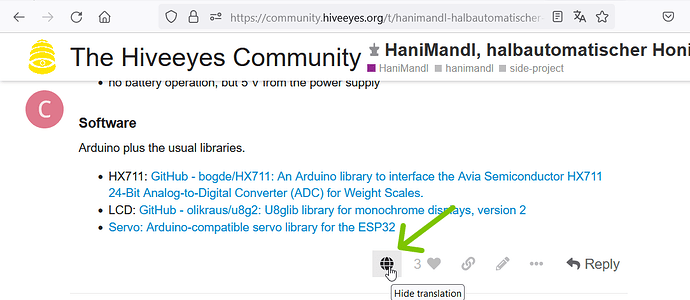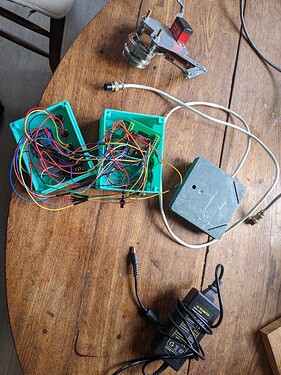Hi there!
Last year I was on the market for a honey jar filling device, as my apiary expanded.
I learned about a commercial version of the Hanimandl and tried to buy it , but it wasn’t available at the time. Then I found this project and understood it was an open-source project that I (maybe) could build myself for less money and less time than to wait for the commercial one to be delivered.
It has been quite the journey, searching through progamming forums in German and tweaking to adapt to the evolutions of the available hardware (pinouts don’t always stay the same). I finally managed to get it to work as intended, with a Heltec wifi kit V3 and a big OLED display on SPI (so no soldering). It works very well, and every smallscale beekeeper I show this to is abolutely extatic about the project and its achievements.
The point of me telling you this story is just to illustrate that Hanimandl is an absolutely awesome project, and that it is a shame that it has not gone out into the world as much as it deserves.
The biggest barriers to getting this project to as many people as possible I think are of 2 different natures:
-
First is language: As the Hanimandl takes its origin in a German-speaking space, and its source code is entirely in German, it is very difficult to even learn about the existence of the project, and even more difficult to adapt it and make it evolve.
-
Second is Hardware: As time goes by, some manufacturers tend to evolve their hardware, which makes it pretty difficult to deliver an out-of-the-box solution for people with less time or knowledge to use. A good exemple of that is the Heltec module which had its pinout change between version V2 and V3. (I had to completely rework and understand the pinout, a real pain).
Also, some components are way more expensive than they need to be, which can be a barrier as well for people with less money to invest.
As you can see, there are many extremely positive points about this project, but also a few dangers looming over it:
- it is a very effective, low budget device that can solve many people’s problems regarding filling honey jars (if you are not convinced of that, go and look online for a commercial solution, you’ll know what I mean)
- it lacks accesibility because of language barriers, hardware choice and code stability. So much that it may one day fall into oblivion, or be so much obsolete that it isn’t useful to anyone anymore.
I would like this to get better.
What I want to do:
-
Translate everything to English:
-code and commentaries (for example, use “Angle” instead of “Winkel”)
-dialogue boxes (GUI)
This should be fairly easy, though time consuming.
But English only wouldn’t be very satisfying, a better thing would be to create a menu option to switch between languages in the user interface. Looking for answers, I stumbled upon this :
https://forum.arduino.cc/t/select-languages-at-compile-time-for-dynamic-multi-lingual-array/613976
But I have no idea about how to implement it, nor if it is possible. -
Choose hardware and create code that is adapted to a stable and affordable platform
I was of course thinking of the standard Esp32, barebones with no screen, very cheap, with an external OLED screen.
What I can do:
Translate, spend time testing, do simple adaptions of existing code; adapt and translate existing documentation
What I can’t do and need some help for:
Make relevant hardware choices for the future, create completely new code that requires more than absolute beginner coding knowledge, create new documentation from scratch.
What my motivations are:
Give the Hanimandl to the world, so that all the good and hard work that has been done so far is not for nothing, and help resolve people’s problem through open source an DIY, which I think is the way for a likeable future.
Of course, I am also writing this post to ensure that no other attempt at doing this is already happening, so if you know of some work in progress please let me know.
Alright, I know this was a pretty long 1st post on my part, thank you for reading this far, and please tell me what you think about all this!

